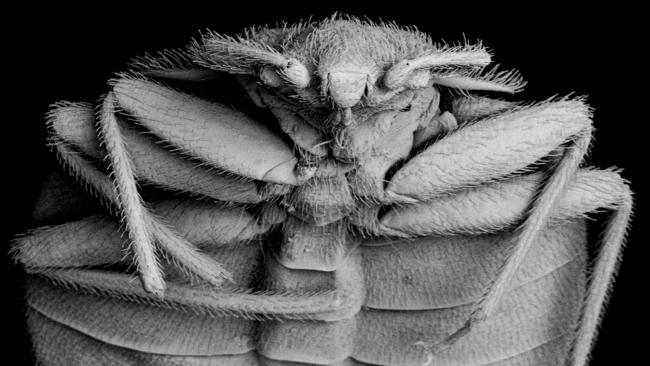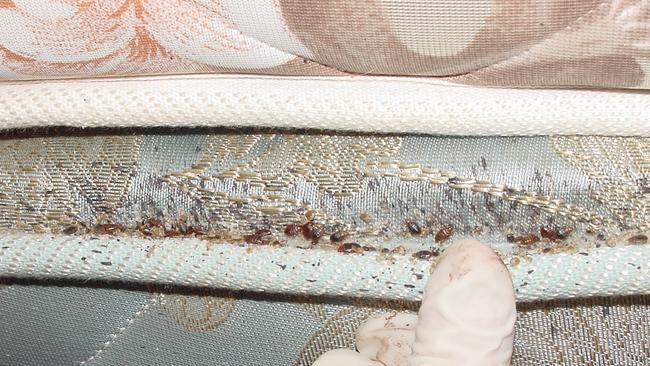Prepare for the bed bug apocalypse: They’re getting harder to kill
BED bugs are getting harder to kill, and we could soon be fighting a losing battle against this terrifying six-legged army. Aaaargh!

“GOODNIGHT, sleep tight, don’t let the bed bugs bite”, was a rhyme my mum jokingly recited as she tucked me into bed and switched off the light every evening.
I never saw these bed bugs when I was a kid, but I imagined them as mythical creatures living between the bed sheets. It wasn’t until I was much older that I realised they were actually a real thing.
At medical school my professor recounted tales of bed bug infestations, where tiny insects forced hotels to close their doors and businesses to become bankrupt.
Pest controllers have kept the bugs at bay for decades, but our treatments are failing and these nocturnal insects are becoming an even greater threat to sound sleepers across Australia.
BED BUGS ARE BECOMING RESISTANT
Insecticide used in the 1950s successfully killed off the vast majority of bed bugs, but the toughest ones survived. Pest controllers now need to use a variety of different chemicals and much higher doses to effectively eradicate them.
We’ve been wondering for decades how they’ve been getting around our treatments. Suggestions have been made that they’re producing complex enzymes to metabolise insecticide more quickly — but the actual answer may be a lot more simple.
The outer surface of a bed bug is called a ‘cuticle’ and Australian entomologists recently measured the cuticles of treatment-resistant bugs compared to bugs that were easily killed. They found treatment-resistant bed bugs had cuticles that were up to 15 per cent thicker than other bed bugs.
It’s like these bed bugs have grown tiny, thick raincoats to protect themselves from our insecticide sprays.

As bed bugs grow thicker ‘skin’, our ammunition gets weaker. We could soon find ourselves fighting a losing battle against this terrifying six-legged army.
HOLD UP, WHAT ARE BED BUGS?
Bed bugs are small, oval-shaped creatures that feed solely on the blood of animals, including humans. At night time they scurry over to your peacefully sleeping body looking for a good feed.
These crafty critters have a long beak and they use it to pierce your skin and suck up your blood. There’s a mild anaesthetic in their saliva, so you don’t feel them bite when you’re asleep.
Their bodies are flat when they’re hungry, but they swell up to the size of apple seeds when they’re full. It takes about three to 10 minutes for them to feed and get fully bloated from your tasty blood.
After a satisfying meal, they waddle back to their nest like a jaunty sailor making his way home from the pub. They’re happy to chill for three to five days before coming back for another night time feast, but if there are enough bugs in your house, they’ll take it in turns so you’ll get bitten every night.
Scratching yourself awake is never pleasant and your day will be preoccupied with finding multiple welts all over your body. Allergies and mosquitoes are often blamed for these itchy red marks, while bed bugs tend to be forgotten and live to bite another day.
HOW DO THEY GET INTO YOUR HOUSE?
Bedrooms, hotels, gyms and offices are frequently infected and bed bugs can hitch a ride home on your clothes, shoes or in luggage.
Second-hand furniture can also act as a ‘Trojan Horse’. That old couch might have been a bargain, but it may also be harbouring an entire colony of biting bugs.
Just like unwelcome relatives, once they’re inside your home it can be really hard to get rid of them.
HOW DO YOU KNOW IF THEY’RE ALREADY THERE?
Bed bugs live together in groups. They hide in mattresses, bed frames, headboards, drawers, behind electrical outlets, beneath carpet and even underneath wallpaper — anywhere close to your bed.
Live ones are sometimes seen moving along the seams of your mattress, but you might only see the old skins they’ve shed or their tiny poo.
Itchy marks in the morning may not be an allergy or even a mosquito. Keep an eye out for bed bugs and check the corners of your mattress.

HOW DO YOU GET RID OF THEM?
Many people repetitively vacuum and steam their carpet, but this will only bring you to tears. Encasing bed frames and mattresses in plastic will give you a crinkly nights sleep, but won’t help get rid of the problem as they can survive for nearly a year without food.
It’s best to hire a professional to find where the bed bugs are hiding and use the most appropriate insecticide — while it still works. Unfortunately due to them becoming resistant to our usual treatments you might need multiple visits to get rid of these stubborn creatures.

Goodnight, sleep tight, and don’t let the bed bugs bite.
Dr Brad McKay is a GP and host of Embarrassing Bodies Down Under. Find him at www.drbradmckay.com.au or follow him on Twitter @drbradmckay



